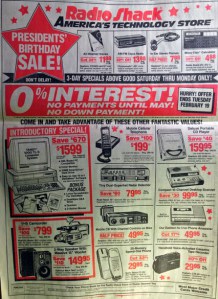Digital disruption on verge of taking out Radio Shack

By Guy Courtin, Vice President and Principal Analyst, Constellation Research

The 94-year-old retailer, Radio Shack, is on the verge of no longer being in existence. Sad, but another example of digital disruption in the retail supply chain. Radio Shack was one of the leading retailers when it came to cutting edge electronics.
I remember as a kid going there to get a new tape recorder. (I played my first Van Halen cassette in 1984 on a tape recorder from Radio Shack.) When cordless phones came out, Radio Shack was the go to place to acquire such technological marvels. There is a picture circulating around social media about all the technologies you could have at Radio Shack in the 1990s -- technologies that are all now contained in that device we carry in our pockets - the smart phone (see below). Talk about digital disruption.
With the rise of Amazon in the 1990s, as electronics were sold more widely and consumers becoming more digitally savvy, Radio Shack found itself in a difficult situation. The store's footprint was too small to carry the wide array of SKUs that a Best Buy or Circuit City could. (That's not necessarily a long term advantage, as the latter is out of business and the former struggling.) And Radio Shack could not compete with the online force that Amazon had become or the discounting that the likes of Target and WalMart offered.
Read this
Now stories are circulating that Sprint may take on or co-brand some locations. It makes sense for the telecom giant as they look to increase their reach with their brick and mortar stores. Unlike Radio Shack, Sprint only needs to carry a very focused and smaller inventory - just mobile phones and tablets. Wireless providers like Sprint and AT&T benefit from having some brick and mortar for sales but also lean on them for service and customer support. The more intriguing option is the one where Amazon would swoop in and purchase some locations.
This comes on the heels of Amazon opening their first brick and mortar store, something I wrote about a while back. Does this make sense for Amazon? Some are pointing out that Amazon could use these stores to showcase products. Not sure I agree with that. Amazon already has that...it is called Barnes and Nobles, Target, Best Buy, REI, Toys R Us, Dicks Sporting Goods, Home Depot etc...why would they add a cost layer to get something they already have?
They could use the locations for pick up and returns. Hmmm... that I might see as a more viable option. Radio Shack stores have an average of 2,426 square feet, a little bigger but similar footprint to UPS stores. UPS stores range from 800 to 1800 square feet. The Amazon/Radio Shack stores could provide similar services: receiving and holding orders or processing returns. With this level of service, Amazon would not have to worry about carrying SKUs at these locations nor having a large staff to manage need to manage the retail aspect.
Could they also act as smaller distribution centers (DCs)? Why not. As Amazon is also looking to expand their own transportation fleet - in such deliveries as grocery - these smaller outlets could also be staging areas for some inventory. They may even have their own drone delivery assets at each physical location. Don't laugh too loud, this might be closer than we think!
One topic we are covering in 2015 is the transformation of the consumers' home into an extension of the retailer. Amazon moving into Radio Shack locations would allow the online giant to move in this direction. It could give users of such services as Zappos who are used to getting multiple sizes and colors delivered to their home to try on and then return, an alternative channel from which they can return their items. This move might allow Amazon to get a little bit closer to their consumers.